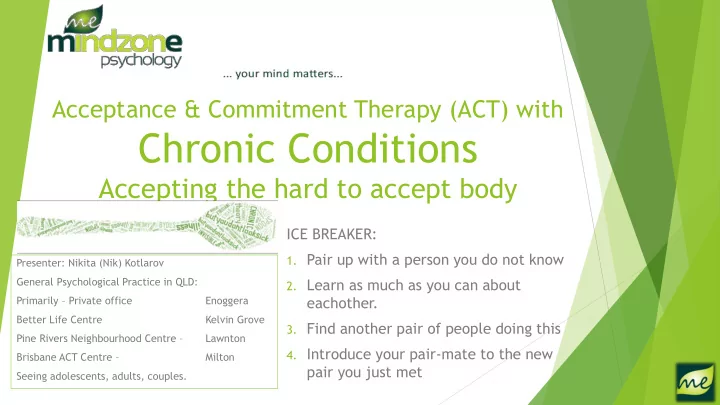

Acceptance & Commitment Therapy (ACT) with Chronic Conditions Accepting the hard to accept body ICE BREAKER: 1. Pair up with a person you do not know Presenter: Nikita (Nik) Kotlarov General Psychological Practice in QLD: 2. Learn as much as you can about Primarily – Private office Enoggera eachother. Better Life Centre Kelvin Grove 3. Find another pair of people doing this Pine Rivers Neighbourhood Centre – Lawnton 4. Introduce your pair-mate to the new Brisbane ACT Centre – Milton pair you just met Seeing adolescents, adults, couples.
Why we do this? Why is this important? Why are you here? Why invest your resources in this? What is important to you about this? Discuss this with the person next to you
Why we do this? If this workshop was to succeed PERFECTLY… You would _____________________?
Why we do this? If this workshop was to succeed PERFECTLY… You would _____________________? Your Client would _______________? Discuss with the person next to you what PERFECT treatment would look like with a Client with Chronic Illness
Why do this? Why we do this? THIS VALUE That you just talked about is WHY WE DO THIS
Why do this? Why do Clients do this? What is the Client asking us to do? What help is the Client expecting from us? What Values bring them here will guide the Committed Action What Pain brings them here will help us understand their experience
Why do this? Informed Consent & Committed Action What kind of therapy? How is it different? TERMINATION – start working on – “My goal is to help you get to the point where you feel you don’t need me anymore.” PAIN – when talking and working in this area is painful INTERFACE – Medical Model vs ACT DISCOMFORT – what showed up when Values were raised? “It’s hopeless ”, “too hard”, “do something that justifies my fee” Worst Case Scenario: - Client feels unheard (ACT doesn’t care about suffering, emotions, etc); - Client feels pushed (another stick, exposure is too fast, etc); - Client feels blamed (in ACT I can do anything, if not, I chose not to); COMPASSION – Notice pain, Kindly, It’s not crazy, Don’t have to fix EXERCISE – crumpled piece of paper (two sides: receiver’s care/respect AND giver’s courage)
Why do this? The ACT Model Functional Contextualism (CBS) Relational Frame Theory
Why do this? The ACT Model Functional Contextualism (CBS) Uses Relational Frame Theory
Why do this? The ACT Model Functional Contextualism (CBS) Uses Relational Frame Theory
ME NOTICING Image from Dr Kevin Polk: www.drkevinpolk.com
Solutions Actions ME NOTICING Threats/Pain Values Image from Dr Kevin Polk: www.drkevinpolk.com
Solutions Actions ME NOTICING Threats/Pain Values Image from Dr Kevin Polk: www.drkevinpolk.com
Solutions Actions DOING what matters/important Things I do to CONTROL Pain ME NOTICING Threats/Pain Values What I CARE about My UNWANTED inner experiences Image from Dr Kevin Polk: www.drkevinpolk.com
Conceptualisation Meet John: Successful, hard-working executive in late 40ies Worked despite industrial noise – hearing loss, tinnitus Tried to ‘push through’ – but found extremely stressful Multiple medical tests and treatments – wears an Aid Could not return to same performance – retired completely Some difficulty engaging in health and social activities Treatment goal – “make sure I’m doing all the right things” Use ‘artistic licence’ to imagine what Values guide John and what his struggle is. Feel free to consider own Client instead
Conceptualisation Welcome back! Use the HOMEWORK results to conceptualise what it is like to be you. What are the unwanted fears, insecurities, annoyances, losses, and pain that show up? How do you move away? Who /what do you care about, matters to you, is important, which guides what you do? How do you move toward? How does this help you connect better with your Client?
Dealing with PAIN There are ways of dealing with pain Most of us would’ve heard about “… stopping the pain…” vs. “… changing your relationship with …”
Dealing with PAIN There are ways of dealing with pain Most of us would’ve heard about “… stopping the pain…” vs. “… changing your relationship with …”
Dealing with PAIN Metaphor – TATTOO: Think of a person with a tattoo 1. Do they have more than one? If yes – why did they go back for more? 2. Tattoos are Addictive 1. Meaningful 2. Exciting 3. Etc 4.
Dealing with PAIN Tattoo facts***: 1. Between 50-3,000 needle strikes a minute 2. Duration varies - >1hr to several hours 3. Approx 4-5mm depth of needle plunge 4. Particularly painful – bones, cartilage 5. US – 38% of 18-40yo have a tattoo 6. Cost - $45(small)-$150/hour(large) STILL – reportedly a REWARDING experience
Dealing with PAIN Lets tweak the circumstances: Instead of willingly receiving a tattoo, the person was to be kidnapped and dragged down a dark alley way to receive a tattoo against their will. Would it be as rewarding? What would our mind do? What would our bodies do? WHY?
The Struggle Switch Averse Aversion Threat Willing
The Struggle Switch Averse Aversion Threat Willing
The Struggle Switch Averse Aversion Aversion Threat Willing
The Struggle Switch Averse Aversion Aversion Threat Willing
The Struggle Switch Averse Aversion Aversion Threat Willing
The Struggle Switch Averse Aversion Threat Willing
The Struggle Switch Averse Willing Willingness to experience INTERNAL events
PRACTICE Let’s form TRIADS: Client – 1. Share, notice urge to move away, notice unwillingness. 1. Connect with Value. What can be a move toward? Guess Therapist’s Matrix 2. Therapist – 2. Support Client, notice urges to move away, notice 1. unwillingness. Connect with Value. What can be a move toward? Guess Client’s Matrix 2. Observer 3. Guess Therapist’s and Client’s Matrix 1.
QUESTIONS? Do you have any questions? Have we done what you were here to do? Do you have the resources to continue practicing? What would you need to continue your growth?
Thank you! Any questions? Further questions – admin@mindzone.com.au
Recommend
More recommend